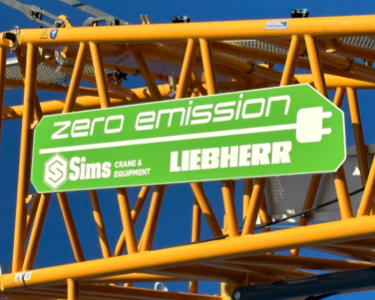Electrifying the U.S. crane market
Sims Crane became the first company in the U.S. to offer an electric crawler crane, helping its clients meet sustainability goals and creating a whole new market.
5 minute read
Key takeaways
- Sims Crane introduced a battery-powered crane in 2023, creating a new U.S. market for electric heavy machinery.
- The effort brought together expertise from Bank of America, crane manufacturer Liebherr and Sims Crane.
- Sustainability is not just about your company — it’s also about taking a wider view of the entire value chain, considering client goals, alignments, risks and opportunities.

Sims Crane & Equipment Co., a third-generation family-owned business, has led the crane and rigging rental industry in Florida and the Southeast for 65 years. It offers equipment for heavy lifting and hauling for construction and industrial projects, with an ethos built on innovation, strong safety practices and a client-focused approach.
Breaking new ground
It was this commitment to innovation that led Sims Crane to the idea of electric cranes. The company knew it had to add to its fleet of crawler cranes but was coming up against supply chain issues for diesel models. Meanwhile, Bank of America was helping Sims Crane to think about how sustainability could impact its business and operations, encouraging the company to solve supply challenges in innovative, unexpected ways. Juliana Henao, client development specialist at Bank of America, says, “When we researched how many Sims Crane clients had their own sustainability goals to fulfill, it revealed a business opportunity and the potential for being an innovator.” So, in 2022 an idea was born — to add a battery-powered crane to the fleet. It would help end-clients reduce their emissions and give Sims Crane the opportunity to be the first among its peers to use an electric crane in the U.S.
Realizing what’s possible
Sims Crane started their journey by visiting the Liebherr facility in Nenzing, Austria, to get educated on electric crawlers. After Deborah Weber, chief executive officer, approved the initiative, Tim McDaniel, corporate sales, and Michael Kuffermann, vice president of fleet operations, went directly to the manufacturer, Liebherr, to explore the crane’s capabilities. “I didn’t realize at the time how much electric equipment had already caught on in the European market, where there are already about 35 cranes in operation, but they’ve perfected it and are rolling out quality machines at scale,” adds McDaniel.
“We went to the Liebherr facility in Nenzing, Austria, to get educated on electric crawlers and were blown away. I didn’t realize at the time how much electric equipment had already caught on in the European market”
Laying the foundations
Seeing the crane in action was the turning point in the company’s decision, allowing Lester and McDaniel to provide a complete rundown of the crane’s capabilities to Weber and the executive team. The company also met with some of the largest clients in its four major markets and found that they were equally excited about the prospect of a battery-powered crane and the positive impact it would have on their sustainability efforts. Sims Crane also felt that the new equipment would give it a competitive advantage and a new potential revenue stream. With all these factors in mind, the company took the decision to purchase an LR 1250.1 unplugged electric crane in November 2022.
Changing operations — and minds
The crane’s battery-powered engine eliminates carbon emissions and is capable of operating for up to eight hours unplugged, or for an unlimited amount of time when connected to a power source. However, introducing an electric crane to a company that only owned diesel equipment required extensive planning. Lester says, “Some of our biggest hurdles were charging and storage. But while the structure of our site had to change, like bringing in power to charge the crane, people’s roles and knowledge had to evolve too.” For example, crane operators had to learn new skills. Luckily, the electric crane operates in a similar way to certain tower cranes, so Sims Crane was able to use these employees to cross-train crawler technicians. Having a workforce with skills across both diesel and electric equipment sets the company on a path to quickly adapt to new fleet additions down the road. The company also found Liebherr to be a great partner, supplying additional training and education and answering any questions. “Their support was tremendous, and they even helped us get in contact with other groups using electric equipment,” says McDaniel. Sims Crane also focused on educating clients, producing materials and explaining the benefits.
“Some of our biggest hurdles were charging and storage. But while the structure of our site had to change, like bringing in power to charge the crane, people’s roles and knowledge had to evolve too.”
Seeing is believing
Giving people the opportunity to see the crane in action proved very powerful. As McDaniel says, “You can have a meeting, give clients all the data, but if you actually show them the crane’s capabilities, they’ll see for themselves how it could help their project.” Sims Crane had a grand unveiling in September 2023, with around 150 people attending. Lester says, “Getting it out into the market, educating people and being prepared to talk about how it could be beneficial. That’s what helped generate interest.”

Sims Crane's LR 1250.1 unplugged electric crane is pioneering a new market for battery-powered equipment in the U.S.
Building a new model for sustainability
As with any strategic investment, the electric crane purchase had upfront expenses, but after the company's customer research, it was clear that there was a strong business justification, including cost savings. “We can charge the crane in four hours overnight, taking advantage of non-peak hours to save our clients some money,” says McDaniel. Going electric also eliminates diesel fuel costs and removes the need for a site to come to a standstill for refueling. Another key advantage is noise reduction — the electric crane is significantly quieter than its diesel counterpart. “We work in high-density, large metropolitan areas, and this lets contractors work for longer without disturbing people,” says Lester. On top of this, going electric creates a better work environment — zero emissions mean less pollutants to be breathed in.
Forging your own sustainability path
The success of this initiative has lessons for other businesses — taking this kind of 360-degree view could reveal new opportunities. Alice Sartory, senior relationship manager at Bank of America, says, “Sustainability is not just about the carbons you are emitting as a company but looking across the entire value chain and thinking about your customers’ goals too.” For Sims Crane, the key to success was partnership — with Bank of America, clients, employees and Liebherr — helping make this move a game changer. Forging these alliances early in the process can make the project easier and create new relationships that may be useful down the line.
“Sustainability is not just about the carbons you are emitting as a company but looking across the entire value chain and thinking about your customers’ goals too.”
Powering a new market
It takes courage to be an innovator, and Sims Crane thought outside the box to bring a new solution to its clients. Demand is growing, and the company is at the forefront. A new electric crane is arriving soon, with plans for more, plus hybrids and some different models as the popularity of electric cranes develops. McDaniel says, “We’re ahead of it, and hope we’ll be known as the pioneers for the U.S.”
Tim McDaniel | Regional Sales Director, Central Region, Sims Crane
Alice Sartory | Senior Relationship Manager, Global Commercial Banking, Bank of America
Corporate sustainability insights
Bringing you the latest sustainability insights to help you grow your business responsibly is a priority for us. From understanding the impact of key trends to providing solutions and financing for green projects, we’re here to help you evaluate the opportunities.



